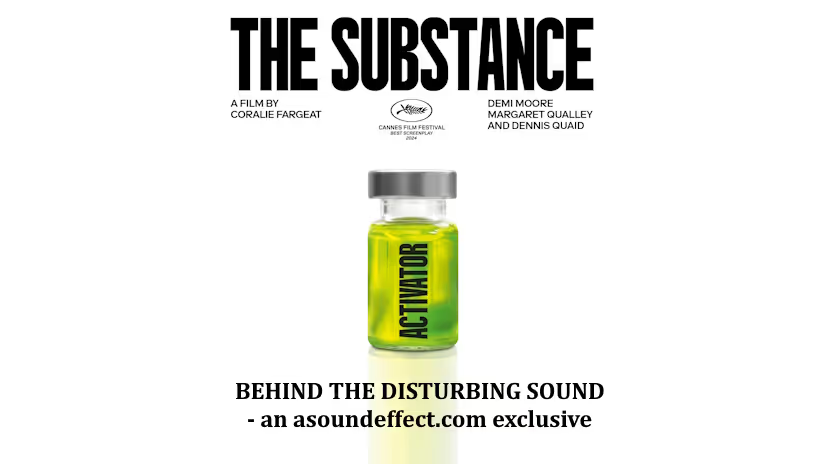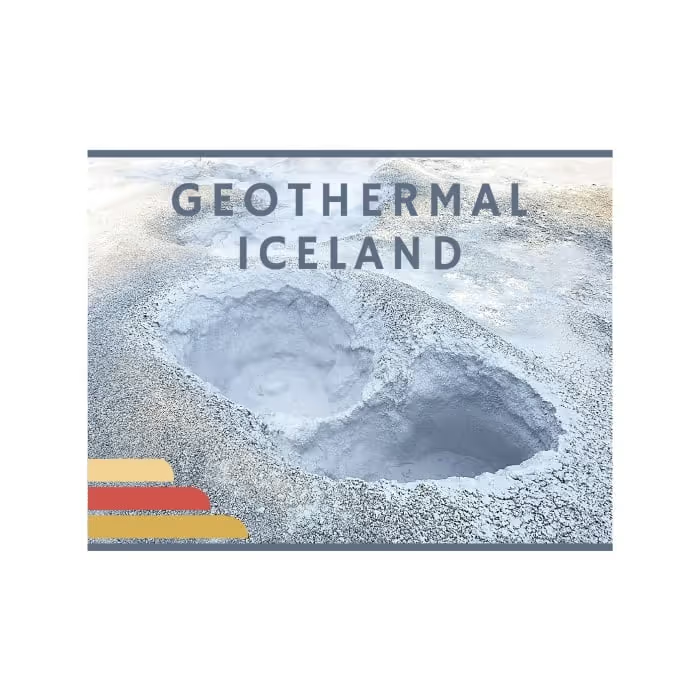In The Substance, Director Coralie Fargeat shows the extremes of chasing unending youth and trying to live up to unrealistic expectations of beauty. The film follows celebrity Elisabeth Sparkle who is fired from her fitness show and decides to take a black-market drug that promises to create a ‘younger, better version’ of herself. The drug creates ‘the other’ version of Elisabeth, who calls herself Sue. Sue is selfish. And what she takes for herself, she takes from Elisabeth.
Here, sound designers/sound editors Valérie Deloof and Victor Fleurant and foley artist Gregory Vincent talk about their unique approach to recording sounds to create internal perspectives, designing sounds for the film’s body horror, using sound to dehumanize and humanize characters, and much more!
THE SUBSTANCE | Official Trailer
The Substance opens with Elisabeth Sparkle (played by Demi Moore) getting a star on the Hollywood Walk of Fame, the passage of time, and the fading of her career (i.e., the star cracks, people ignore it, drop food on it, etc.) is told through sound. Can you talk about building this sonic montage?
Valérie Deloof (VD): This first sequence is the last one we edited. There were a lot of takes during the shoot, with a lot of possible sequences. The idea, of course, was to convey the passage of time from fame to oblivion. We decided to make the final indifference of people who pass by noisy, like the cheering at the beginning. The noise that glorified Elisabeth becomes the noise of the city, pushing her into the background. In between, we worked on the sounds in a simple way, without trying to say much more than what the image showed us.
We did some ADR with a group of actors to get a feel for their comments, but Coralie didn’t want them to be understandable, so as not to emphasize what the image was already saying.
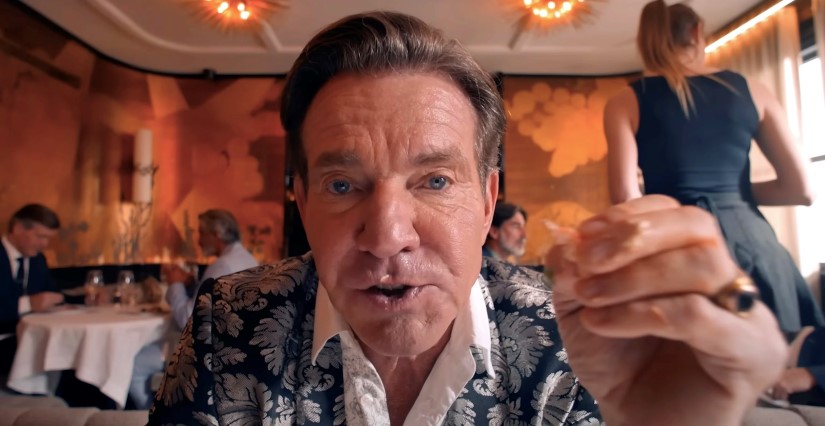
Harvey (played by Dennis Quaid) is morally revolting. In the bathroom, Elisabeth hears his disgusting comments that objectify women, and when she sits down to lunch with him later, her disgust for him manifests in the way she perceives him eating. The sounds are so gross, like the slow-mo sounds of him eating and waving the shrimp around. Can you talk about your sound work for this lunch scene?
VD: Denis Quaid is absolutely brilliant. We played the sound of the TV set and toilet scenes very realistically until his arrival, which takes the movie into another, exaggerated sound dimension. We had to emphasize his obscenity, and the decision of Coralie [Fargeat: writer/director/editor] to have him eat shrimp helped a lot. We created many layers of sound that complement each other to mark the cracking of the shell and the juiciness of the shrimp, as well as its transformation in his mouth. At this point, we also muted all the ambience and music in the restaurant.
We used some sounds from sound libraries, but also made recordings with a stethoscope to get different textures, and the foley added more material.
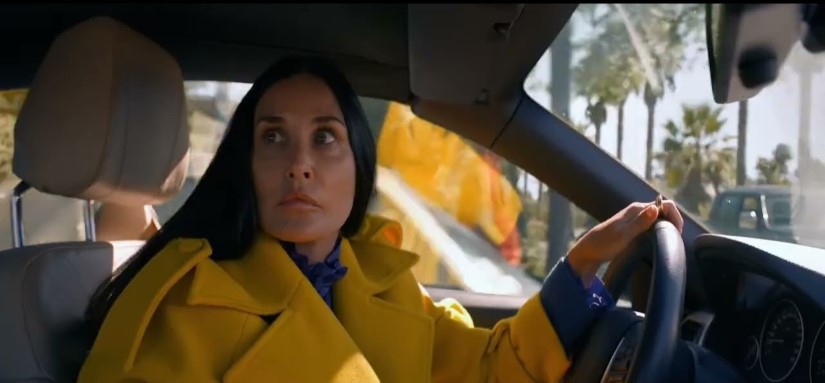
Can you talk about your sound work on the car accident on the scene?
VD: It’s a classic construction. Like all sound editors, I worked with stems, separating out the creaks, shocks, and squeaks of metal or broken glass. The sound of the car’s engine before the accident is very simple – a mix between the production sound and a recording of my own car, which is a small model, and it’s quite continuous, which helps make the accident more spectacular.
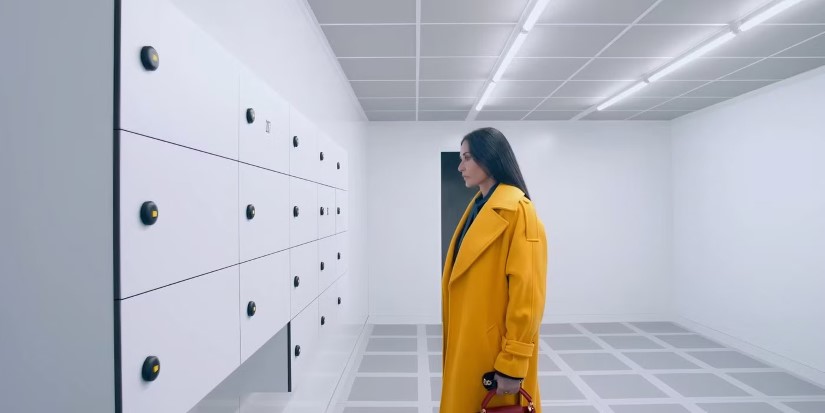
Elisabeth goes to retrieve the substance from the storage facility. It’s not the part of town she’s used to, the location is in a back alley – can you talk about using sound to make the audience feel uncomfortable here? (It just adds to the desperation that Elisabeth must be feeling to go through with a shady medical experiment to reclaim her youth.)
VD: She goes by different places between her apartment and the storage facility. It was important to convey Elisabeth’s feelings. She heads for the unknown. The exterior shots are short, and we marked different spaces in a very symbolic way because of the recurrence of that scene.
I wanted to create an uncomfortable climate by manipulating metallic elements and winds and adding synthetic layers.
The street is noisy, with aggressive music or engines dominating the soundscape. Then, the suburbs become more deserted, with dogs and police sirens that tell a potential danger and mark a territory to which she doesn’t belong. Finally, this area is isolated from everything, deserted, abandoned, an eerie ghost space. While a few passages of distant vehicles bring us closer to a certain realism, most of the sounds are distorted. I wanted to create an uncomfortable climate by manipulating metallic elements and winds and adding synthetic layers. We also put in the sound of crows because of their classical presage of danger. For the corridor, I shaped the sounds in a very musical way, using metallic materials and held notes to give the place an uncomfortable feeling. Finally, for the room inside the storage facility, I only used a low and clinical neon light sound.
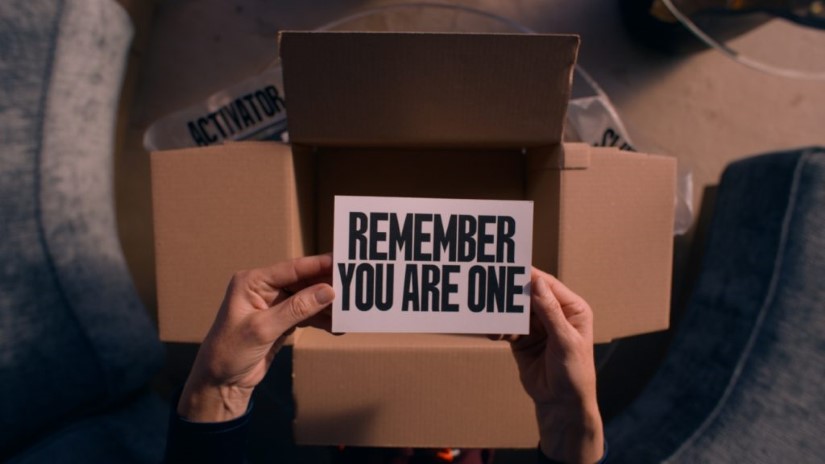
What went into your sound work for Elisabeth’s ‘transformation’ sequence? Can you talk about some of your sound choices for this scene? (It’s definitely a music-driven sequence but then the light tunnel moment kicks in with the voices. Were those voices part of the music track? Or, did you work with the score while creating those?)
VD: When Elisabeth feels the effects of the substance, I looked for sounds that were both soft and brutal. I slowed down some musical instruments, breaths, and screams, tried to create fluid movement and confusion, and added some impacts like blows to her body. I wanted her to seem dematerialized. I wanted us to understand that she’s the one screaming, but it’s not her own voice anymore.
I slowed down some musical instruments, breaths, and screams, tried to create fluid movement and confusion, and added some impacts like blows to her body.
Once Elisabeth is unconscious on the floor, the music starts to settle in and we had to find the sounds we could hear through it, which wasn’t easy because although we knew it would be loud and full, it didn’t arrive until the mixing stage. Coralie gave us a provisional music track, but Victor [Fleurant: co-sound designer/sound editor] and I quickly decided to create a lot of our own music, as we needed a real composition that completely worked with the rhythm of the editing. In the end, many of our musical effects remained in the movie to complement or support composer Raffertie‘s compositional work.
Again, I edited a series of highly transformed human screams and recreated the rubbing of her body on the tiles, gradually distorting them to make them more and more internal.
To open the body, I used soap or wallpaper paste, wet sponge and mop, vegetable or fire crackling, dog food, and compressed air in a bottle. I transformed rock falls, flag movements flapping in the wind, and added vibrations made with a Korg instrument.
I edited a series of highly transformed human screams and recreated the rubbing of her body on the tiles, gradually distorting them to make them more and more internal.
During the tunnel, I used sounds of a volcano, with a bubbling but also chaotic and stony character, a very whistling wind cut like blades, as well as the howling of pigs recorded in a slaughterhouse in China, which I reversed. I’d given Gregory Vincent, our foley artist, a track of Elisabeth’s screams from the production sound so that he could know when I wanted the inside/outside switch to be made. By running this voice through a plugin, he created an incredible random version that was added to my pigs. Gregory also added a brilliant layer of spongy beats.
Gregory Vincent (GV): I used the ProTools “chopper” (by which I mean the random pencil), then a few sounds in reverse to make transitions, and finally a rather classic reverb. However, there is a plugin called Paul Stretch, I believe, which deformed the material quite a bit.
My starting point was the idea that sound should split and fade in reverberation, like the splitting of bodies.
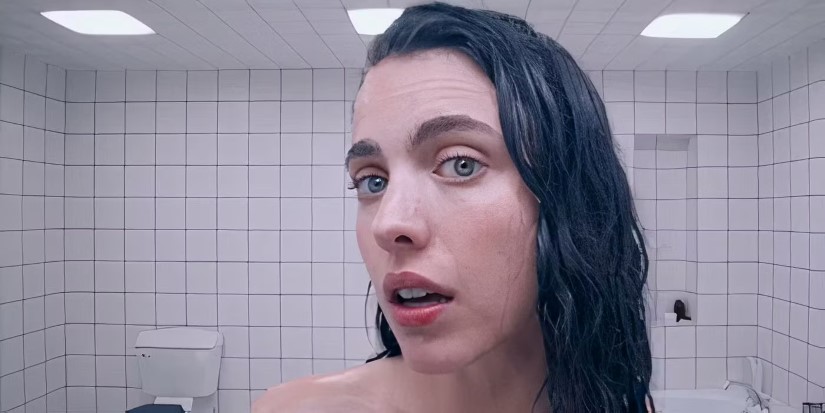
The ‘other’ is born. (We find out later her name is ‘Sue.’) Can you talk about creating sounds from her muffled, interior POV? And before Sue uses the stabilizer, she’s kind of in that same sonic space….
VD: Coralie wanted us to feel the movement of Sue’s body fluids, as if she were made entirely of water or immersed in amniotic fluid. So we used more or less liquid elements to mark her movements.
The final choice was to put microphone capsules in the actress’s ears to hear her breathing through cranial resonance.
As soon as we started editing the dialog, we knew we’d have to find something with the actresses for these subjective sequences. Lucien Richardson, the dialog editor, experimented with several things that he suggested to Coralie. The final choice was to put microphone capsules in the actress’s ears to hear her breathing through cranial resonance. A boom mic and HF mic were added to allow for further edits or to switch to an external viewpoint, which was very useful for this sequence when Sue steps back from the mirror.

Can you talk about designing the sounds for stitching up Elisabeth’s body? And for drawing out the spinal fluid/stabilizer with that intimidating syringe?
VD: The bathroom was very large and very reverberant, and of course, there were no HF mics, but there was still a lot of interesting material in the production sound. I used ‘deconstruct’ in RX iZotope to isolate the little handling noises, which I then clarified and completed.
The triggering of the capsule is reinforced by the handling of a pistol; the impact of the syringe is extremely brutal.
Of course, I added everything bloody. Victor had done a whole session of recordings of more or less juicy vegetables before the editing, which I used a lot for the flesh, but apart from that, I relied mainly on realistic sounds, which makes this sequence quite uncomfortable. I had to be extremely precise and not overdo it because I wanted to be very surgical to make it believable. The very close-up image encouraged this.
When Sue starts to suffer from tinnitus, the sound changes register and shifts towards a certain exaggeration. Muffled vibrations for a subjective point of view and this tinnitus marks the urgency and pain. Lots of effects were created using synthesizers and tuning fork vibrations. The triggering of the capsule is reinforced by the handling of a pistol; the impact of the syringe is extremely brutal. It’s a necessary brutality, one inflicted on the body to maintain it in this new form of beauty and youth.
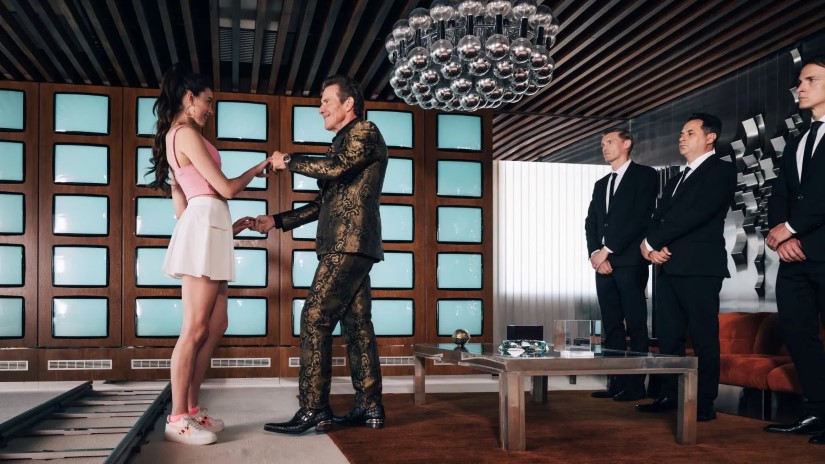
What went into the sound of Harvey’s shoes?
VD: Harvey is a caricature. The vulgarity of his words is also the vulgarity of his attitude and his clothes. He has all the power, which is shown in his ease and the way he imposes himself, looks at others and considers them. The idea of metal shoes came from Gregory Vincent. Gregory has done a lot of animated movies, and he has this culture of characterizing through sound. It’s a brilliant idea.
GV: The idea came from the boldness of the shot. The boots were so huge inside the frame that I looked for the necessary density. I wanted the shine and the weight to be close to the visual sensation of metal heels. When I found the sound, I thought it would be funny to inflict this blinged-out heaviness on it all the time.

Sue doesn’t switch when she’s supposed to and experiences the adverse physical effects of destabilizing. She extracts more spinal fluid/stabilizer to prolong the transformation, but Elisabeth suffers. Can you talk about your sound work for this sequence?
Victor Fleurant (VF): After the success of her first “Pump It Up” show, Sue goes to a party rather than switching with Elisabeth. She returns late, accompanied by a man. As they kiss and caress, Elisabeth’s food bag completely finishes. Sue must recycle a capsule and extract more spinal fluid to prolong the moment.
We chose a zipper that could match with the straw-suction sound and recorded it at 96 KHz to slow it down.
Before Sue develops tinnitus, there is a parallel between Sue and Elisabeth. In the sound, we tried to intensify this contrast and create links between the two actions. On Sue’s side, we exaggerated the sensuality. The breathing is very strong and close. We added a lot of mouth, lip, and tongue sounds (elements that tend to be lowered in films). We recorded some of the presences and caresses very close up and in stereo, looking for textures that would easily come out with music. As with many other moments in the film, we edited the sounds punctually and precisely rather than continuously. A first connection to Elisabeth is made between the sound of the zipper and the suction of the food bag. We chose a zipper that could match with the straw-suction sound and recorded it at 96 KHz to slow it down. The second connection to Elisabeth is made with the leather texture we added to the rubbing of the clothes, which blends into the food bag coming to an end. This sound of the leather/bag contracting to the extreme triggers Sue’s crisis.
The breathing changes from internal to external, thanks to the intra-binaural system imagined by Lucien Richardson.
As this crisis is the first of its kind in the film, we had to emphasize its violence. The breathing changes from internal to external, thanks to the intra-binaural system imagined by Lucien Richardson. The violence of the discharges comes from the impact of a plugged/unplugged guitar amplifier and a series of tinnitus waves. A few times we added accelerating heartbeats to add rhythm. We wanted to emphasize the urgency with a rumbling bass texture, sometimes musical, sometimes windy. This rumble is present until the moment Sue finally stabilizes herself. Some of the foley effects were recorded and shaped with saturation and contact mics to emphasize Sue’s partial loss of sense.
Just before Sue stabilizes, we added a layer of a more and more saturated and compressed sound that is suddenly released when she sticks the syringe into her thigh. The sound of Sue’s sudden revitalization is built on many layers, but the main ones are tonal ascents worked from breaths, viscous swarms, and metallic resonances, all reversed.
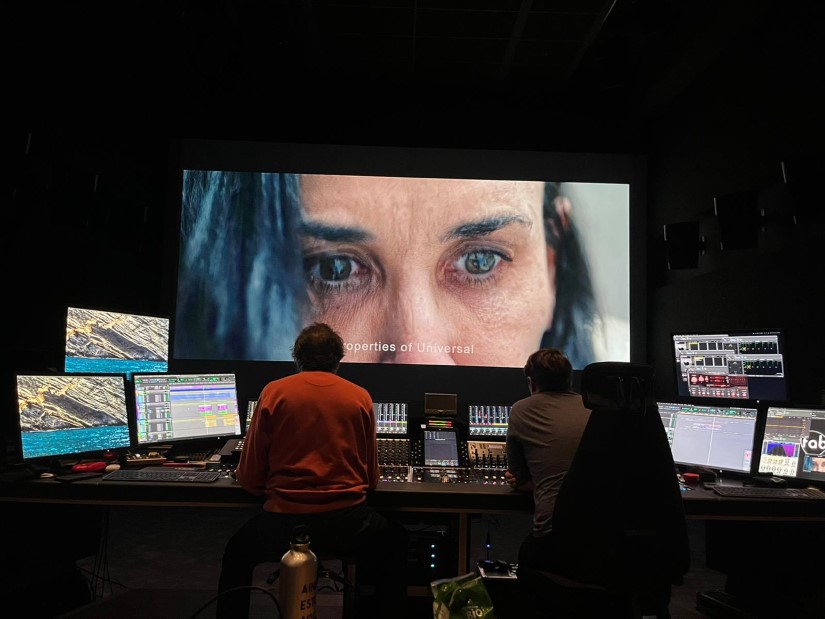
Elisabeth finally gets her body back after Sue prolonged the switch still further. And Elisabeth, now aged considerably, cooks a bunch of things in the kitchen. Can you talk about your sound work for this cooking scene?
VD: This sequence was complicated because we had to balance Elisabeth’s actions with the sound of the television and the music. We also had to mark a crescendo in Elisabeth’s anger, making her gestures increasingly violent and desperate, while respecting the comedy of the scene.
The sound recordist had captured some cooking actions on the set, and I also had some sounds of food manipulation, particularly chicken carcasses.
The sound recordist had captured some cooking actions on the set, and I also had some sounds of food manipulation, particularly chicken carcasses. We decided to exaggerate each action, adding a chainsaw to the egg mixer’s close-ups and making the eggs brutally explode on the wall – I think that brings something both comic and tragic to the scene.
We also wanted to support certain moments with effects that mark an action and at the same time say something about the mental state of the characters, for example when Elisabeth throws her recipe book on the table and follows a recipe with her finger, or with the “Pump it Up” show on TV with effects that mark her sensuality.

Elisabeth, who has aged substantially since Sue drew far too much stabilizer/spinal fluid out of her, tries to kill Sue. But then Elisabeth changes her mind and does a switch. Now, Sue and Elisabeth fight with each other. What went into the sound of their fight?
VF: Things don’t get any better in The Substance. Elisabeth’s body deteriorates while Sue enjoys herself. And every time one comes into contact with the other, we’re surprised at how much worse it can get. That’s why the face-to-face between Elisabeth and Sue is so chilling. It’s the first time they see each other in real life, and Elisabeth has just tried to kill Sue. We soon realize that Sue will try to do the same in order to survive.
…some of the impacts are specifically designed to feel painful, such as the hit of Elisabeth’s head on the bathroom sink, which has no less than 29 layers.
What was difficult in creating the sound for this violent outburst was to match the intensity of the moment. Unlike the other bloody sequences in the movie, we have to be afraid for Elisabeth, to mark the brutality of what’s happening without going too far. So we worked with rather realistic textures, without overdoing the bass reinforcement or impact enhancement. For example, when Elisabeth is thrown against her portrait in the living room, we focus on the nature of the impact rather than the shards of glass falling on the ground. When they run in the corridor, we overlaid the foley elements with some footsteps coming from the production sound to try to make it more intense. We focused on every element of the set that we could bring to life to tell Elisabeth’s fear without overdoing it. (The latch, the door, the bathroom cabinet, the accessories on the furniture, the wooden planks on the floor, the squeak of the bathroom tiles, etc…)
Still, some of the impacts are specifically designed to feel painful, such as the hit of Elisabeth’s head on the bathroom sink, which has no less than 29 layers. For the smashing series against the mirror, we’ve added more and more textures of torn human flesh. When Sue finally kills Elisabeth by kicking her, the much more symbolic violence led us to work the impacts in a mental, almost musical way, like drums.
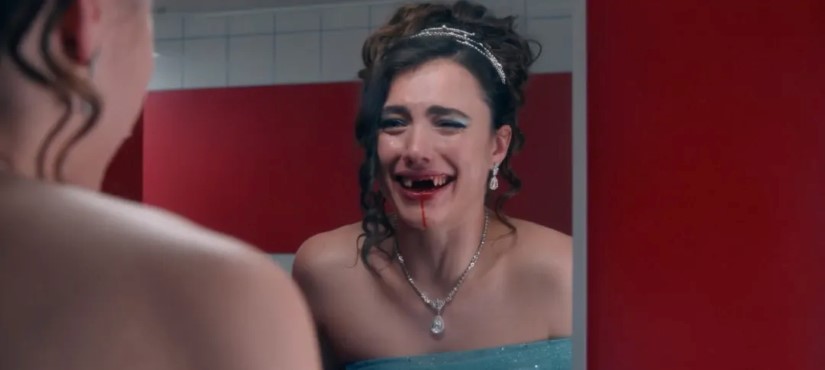
Sue is on her own after she kills Elisabeth. She experiences tinnitus and this weird cough (cool sound for that!). Can you talk about the sound for Sue’s decay, like her pulling out her teeth? Her nail popping off? Her ear falling off and that changing how she hears things?
VD: The cough is a mix between the production sound and the one she recreated in ADR using the microphone capsules in her ears. That’s what gives it its weirdness. For the teeth, it wasn’t easy to find the right balance between internal and external sound, because to make the sound of teeth hurt, you have to use slightly high-pitched material, like cracks, stone, or bone. I used a lot of bumps on the mics because their proximity and saturation are aggressive.
For the teeth, it wasn’t easy to find the right balance between internal and external sound…
When Sue is in the elevator, Coralie had already, in her edit, transformed the voice of the man talking to her (who is our producer), so I knew how Sue could hear things around her. The main sound of the nails is eggshells.
For the general perception of Sue, I used sounds recorded with a stethoscope placed on a throat, because the slightest movement can make terrible noises. So it’s an editing of all the accidents on microphones I could find, which allowed me to give the impression that Sue’s body was deteriorating.
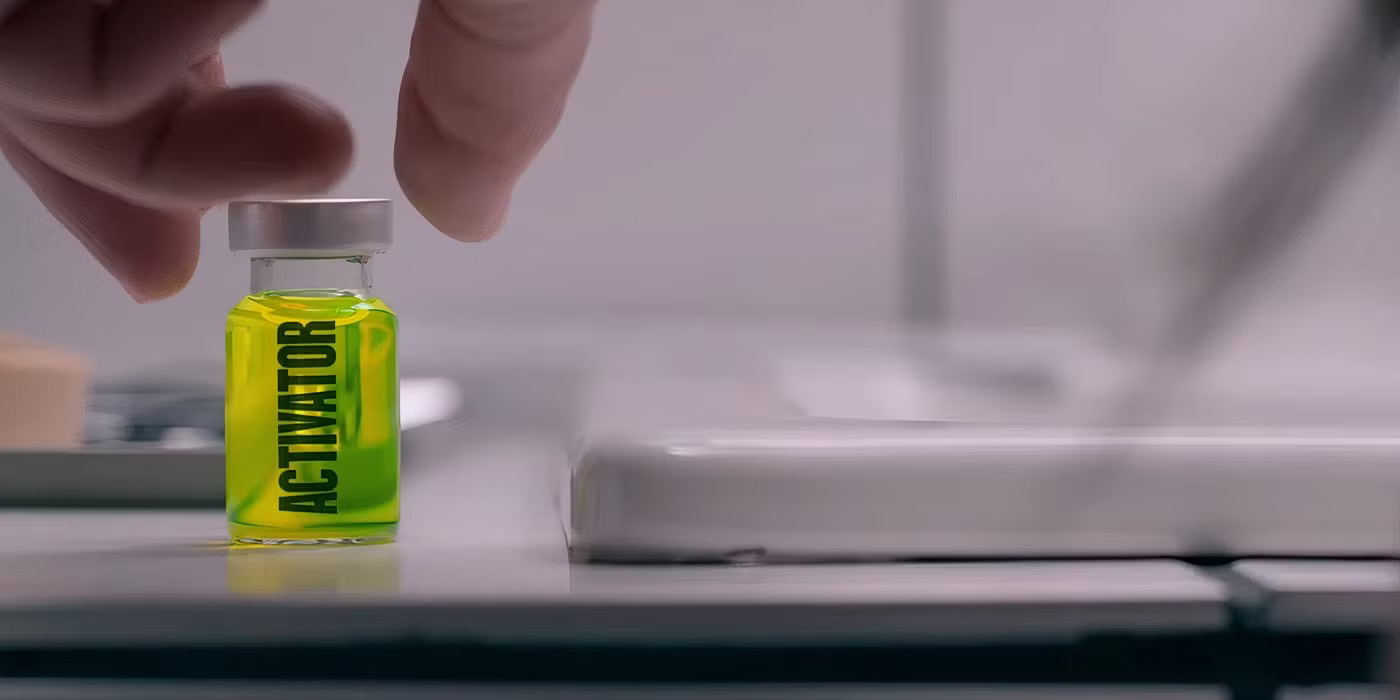
Sue injects herself with the activator and goes through the transformation. Can you talk about the sound for this scene?
VD: There’s a sense of urgency and panic between the moment Sue starts to deteriorate and the moment she falls after injecting the substance. The sound had to be chaotic to capture this, but also understandable. One way of doing this was to alternate between an inside and outside perspective, changing the dynamics of the scene, giving disorientation, and allowing us to choose the effects that would give energy and make Sue’s anguish most palpable. This disorientating alternation allows us to hear both Sue’s heartbeat and the full force of her final ‘come on.’
The tunnel had already been done with Elisabeth/Sue, but we needed to make it different and even more heartbreaking. To have aggressive screams, I used sounds from the Hiss and Roar collection called “GLASS Unusual,” which are impressive and really do sound like screams.
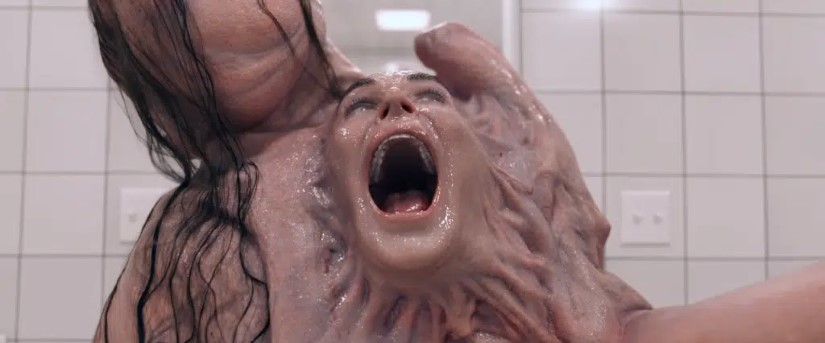
How did you handle the sounds of MonstroElisasue? (Her movements, her breathing, her jangly earrings…)
VD: I only edited the birth of MonstroElisaSue; Victor edited the end of the film. Actress Margaret Qualley did the ADR with the intra-binaural mics, but she also had a teeth retractor so we could mix throat sounds with drool. It was completely crazy. Then there was a very precise montage of the voice and breathing, mixing different takes. Elisasue had to be heavy and viscous at the same time, so we had to mark her movements with liquid sounds, and put low, heavy impacts on her steps. For the subjective part, before we saw her, we used deglutition sounds recorded with a stethoscope placed on a throat.
When she was in front of the mirror, we had to continue with the heaviness of her movements and find materials for her movements, which wasn’t easy because it could quickly become plastic. We used the sound of a wet mop and stomach sounds recorded with a stethoscope. I’d asked Victor to make a microphone out of a stethoscope before I started editing. As he’s very conscientious, he ate 1kg of fermented cabbage and drank 2 liters of sparkling water, so we ended up with some incredible sounds…
VF: For mixing purposes, we needed to define precisely everything that characterizes MonstroElisaSue. To do this, we separately imagined her footsteps, her breathing, her way of speaking, her movements, and the sound of her accessories.

Vocal designer Lucien Richardson took charge of creating her breathing and her way of speaking. The vocal parts are all performed by Margaret Qualley. To record the performance, Lucien used the intra-binaural stereo mic set he invented for the POV moments. He also asked Margaret Qualley to use a medical-grade dental apparatus to stop her lips from closing and her tongue from moving freely. This way, her performance was close to when she wore the on-set costume of MonstroElisaSue.
For the sound of her body, Coralie Fargeat’s goal was to make MonstroElisaSue as human as possible. We wanted this character to be as emotional as Elisabeth can be. For example, we had made a first version in which the monster was animated with leather and clothes textures. Coralie made us change direction, partly to avoid the sound being confused with the costume on set, but also to feel more “realistic” and closer to the character.
The final sound of MonstroElisaSue is therefore conceived from several distinct aspects. First, there’s a global texture to feel her viscous presence, audible as soon as the camera is close to her. We built it out of several viscous layers (vegetables and mops) to keep the sound alive, as if her cells were in constant activity. For each arm or leg movement, we worked with a layer that was also viscous, but more slimy and precise, so we could detail each action. Only the sound of her footsteps is slightly exaggerated. We created a monster that weighs 2 tons instead of 150 kg. (This layer is composed of butternut, a mop hit, and a bass hit). It’s a body that imposes itself in public space.
To make the character more human and touching, we had to add a certain magic, and this was achieved in particular through her earrings. After several versions, we came back to a version that Coralie Fargeat had made herself, using small bells with a crystalline sound. With the occasional support of foley effects, the final sound is made up of this texture. We placed it very punctually and not all the time so that it would be noticeable and evoke an almost fairy-tale-like imaginary world.
The POV shots are an overlay of Margaret Qualley’s recordings with intra-binaural microphones and a mix of intra-intestinal sounds recorded with stereo stethoscopes.
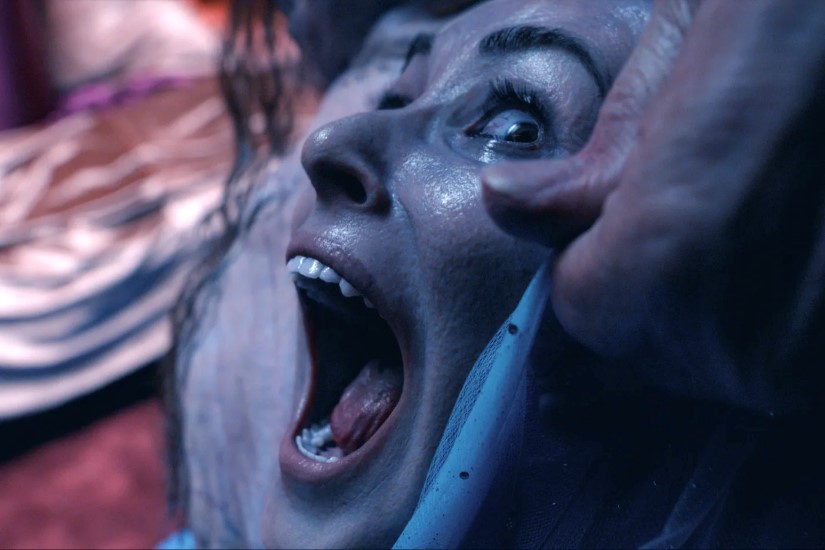
What went into your sound work for MonstroElisasue’s on-stage ‘performance’?
VF: As MonstroElisaSue enters the stage, to the music of Strauss, we’re constantly wondering when her true nature will be revealed. The heaviness of Monstro’s steps and slobbering voice echo through the auditorium. When the mask falls, it triggers an immediate physical reaction: Monstro begins to vomit, rejecting an organ.
The sequence is built as a parallel between the audience and Monstro’s vomiting. We tried to keep the audience’s reactions as simple as possible. What we hear is mostly mono, using close mics. To keep the back and-forth between the audience and Monstro simple and comical, there are only a few layers.
For the organ coming out of her body, we worked with flesh textures and then bone crackles made from vegetables and mash.
On the other side of the camera, the sound is much more monstrous. To emphasize the guttural, disgusting side of the vomiting, the “vocal” part of the performance is a mix of two sources. The first is a recording the director made of herself simulating vomiting (then pitched down). The second is the sound of hard-digesting intestines, which we recorded at 192KHz (then slowed down) with a pair of stethoscopes at belly level. For the organ coming out of her body, we worked with flesh textures and then bone crackles made from vegetables and mash. We spotted the sound rather than putting them continuously to emphasize the evolution of the action rather than the flesh in general. The “shocking” aspect of the scene works on its own, without necessarily exaggerating, but we did give the final exit from the boob a slimy birth/hatching character.
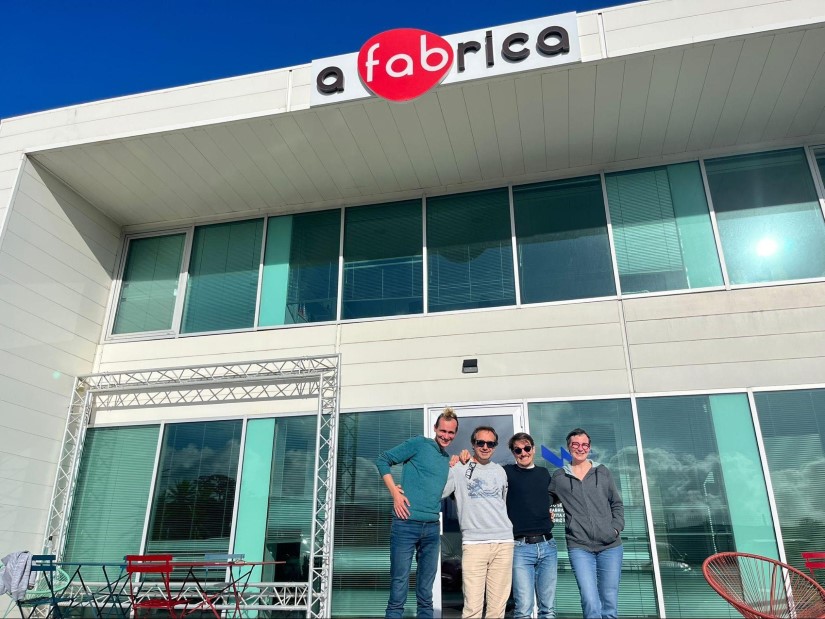
Victor Feurant, Stéphane Thiebaut, Victor Praud, and Valérie De loof
What was the most challenging aspect of the sound design on The Substance? Or, what are you most proud of?
VD: I think the hardest part was also the most exciting: trying to come up with original textures and effects, while at the same time finding the right balance with exaggeration, using sound only where it made sense and felt right, so as not to overwhelm the characters and maintain empathy with them.
What helped was that there were two of us, which meant we could listen and talk about what we were editing, and above all, what helped was to have a director like Coralie, who gave us a lot of freedom yet never lost sight of what she wanted to achieve. She did a lot of the sound effects herself in her editing room. She loves sound, so it was very pleasant to work with her.
I think I’m delighted and proud to have been in line with her expectations.
VF: The most challenging aspect for me was first trying to understand everything that made up The Substance’s universe, and therefore Coralie’s universe. I had to be able to create all the sounds she had in mind.
The way we interpret the blood, the flesh, the inserts (on body parts or on wounds) depends on a delicate balance that we had to find.
We had to be up to the task because all the sound design she had suggested in the editing timeline was already very complete. Because her knowledge of sound design was so precise, she always knew what to expect from us. So we sometimes made several suggestions before we found the perfect textures. But this experience, which could have slowed down the sound design process, turned out to be very positive because we were able to go even further all the time.
What we always tried to find was the right tone for each scene. The way we interpret the blood, the flesh, the inserts (on body parts or on wounds) depends on a delicate balance that we had to find. For example, the first scene of the “Pump It Up” show with Sue, we occasionally hear movements on the skin, sensual breaths, and a certain stylization of sound changes the relationship we have with all these close-ups of bodies. In the same way as the detailed sounds we hear when Sue removes a chicken leg from her belly, the sound slightly shifts the first-person perception we may have of the image. This shift leads us to question the deeper meaning of what we are seeing. A syringe can become a blade, an electric mixer can become a chainsaw, a hip movement can become a gust of wind. In The Substance, nothing is gratuitous.
A big thanks to Valérie Deloof, Victor Fleurant, and Gregory Vincent for giving us a behind-the-scenes look at the sound of The Substance and to Jennifer Walden for the interview!
 Tesla Model X 2015 electric full size crossover SUV sport utility vehicleKrampfstadt Studio65,00 $32,00 $51% OFF
Tesla Model X 2015 electric full size crossover SUV sport utility vehicleKrampfstadt Studio65,00 $32,00 $51% OFF

